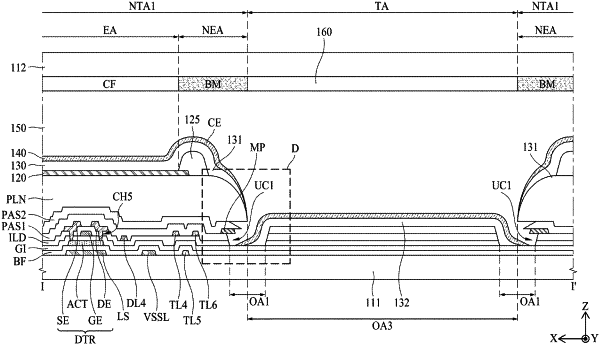| CPC H10K 59/40 (2023.02) [G06F 3/0446 (2019.05); H10K 59/351 (2023.02); H10K 59/353 (2023.02); G06F 2203/04111 (2013.01)] | 20 Claims |

|
1. A transparent display device comprising:
a substrate provided with a plurality of transmissive areas and a non-transmissive area including a plurality of light emission areas;
a plurality of light emitting elements respectively disposed in the plurality of light emission areas on the substrate, each of the plurality of light emitting elements including an anode electrode, a light emitting layer, and a cathode electrode;
a plurality of touch sensors respectively disposed in the plurality of transmissive areas on the substrate, each of the plurality of touch sensors including a touch sensor electrode; and a first undercut structure disposed along an edge of the transmissive area and separating the cathode electrode from the touch sensor electrode, the first undercut structure including a plurality of eaves;
wherein the first undercut structure includes:
a first passivation layer disposed on the substrate, including a first opening area provided along the edge of the transmissive area;
a second passivation layer disposed on the first passivation layer, including a second opening area provided to at least partially overlap the first opening area; a planarization layer disposed on the second passivation layer, including a third opening area provided to at least partially overlap the first and second opening areas;
a first eave in which the planarization layer is more protruded than the second passivation layer in a direction of the transmissive area to overlap at least a portion of the second opening area; and
a second eave in which the second passivation layer is more protruded than the first passivation layer in the direction of the transmissive area to overlap at least a portion of the first opening area.
|